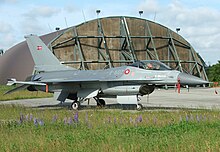Hardened Aircraft Shelter


(MiG-Shelter type GDF, left 1 × open, right 2 × closed, far right muni bunker)



With hardened aircraft shelter (HAS, short only Shelter ) is a means of reinforced concrete vaults and armored doors reinforced aircraft bunker , usually for combat aircraft , designated. This can be covered with earth and overgrown with grass for optical camouflage. With such shelters, the combat aircraft are adequately protected from hits by light aerial bombs and fragments.
history
After the lessons of the six-day war of the Arab neighbors against Israel and its devastating attacks on Arab military airfields , a rethink began. With its ammunition, even a single combat aircraft is capable of damaging or destroying the refueled and ammunitioned military aircraft lined up on an opposing military airfield within a few seconds. The destruction is completed by the subsequent secondary explosions and the resulting heat. To counter this, aircraft shelters made of reinforced concrete were built for one or two fighter planes near the taxiways or runway ends.
In the Soviet Union, the industrial production of prefabricated parts for "arched roofing" began in Kaliningrad's Plant 2 at the end of the 1950s. In 1962, a first Soviet shelter was identified during the evaluation of American aerial photographs in Cuba. In 1968 merchant ships were sighted that were loaded with prefabricated elements for the GSSD . The first of these buildings were built in the same year at the Köthen airfield . In the following years, Soviet airfields in the GDR were equipped with around 800 shelters by 1989.
Further development of the aircraft cavern
Some air forces went a step further by not only building aircraft shelters, but also protecting all infrastructure required for maintenance from air attacks. So tunnels were driven into mountains and so-called aircraft caverns were created. The Albanian , Taiwanese and Chinese air forces as well as the Swiss and Swedish air forces have put such cavern systems into operation. After the end of the Cold War , however, most of these plants in Sweden, Albania and Switzerland were shut down.
Types
Shelters were built for both single and multiple combat aircraft, with those built by Yugoslav companies for the Iraqi Air Force being of the highest technical standard. Those shelters that were built for the USAF at Al Udeid Air Base in Qatar have the same standard . However, these are only visible to experienced observers on satellite photos .
Most shelters are built in such a way that they have gates and exhaust bypasses at the rear so that the fighter planes can start their engines in the shelter. This means they can roll out of the shelters onto the runways when an alarm starts.
On airfields of the Luftwaffe , there are three different generations of shelters. The common shelf type has two different exhaust gas outlets. A box-shaped outlet is used on the airfields where the Tornado weapon system is flown; semicircular outlets are used on the other air force bases. In addition, the two versions differ by an additional 30 cm high cutout at the upper end of the shelf door recess in the Tornado version. The airbase Jever is an exception compared to the other Air Force air bases, as there is on him, the NATO standard Shelter type (TAB-VEE).
In some cases, earth walls are piled up in front of the gates up to the height of the shelter at a sufficient distance to keep blast waves and splinters as well as direct hits from the interior of the shelter and the aircraft, even when the gates are open.
There is another type of shelter in Israel and Saudi Arabia to take the pressure off explosions in the vicinity. These are set into the ground around six meters deep so that the shelter ceiling is level with the ground with sufficient cover. A taxiway branches off and slides over a ramp into a deep hollow. There are around three to four shelters next to each other on both sides. In some cases, there are two depressions as taxiways and a wall in the middle to remove the pressure effect from direct hits. These types of shelters can easily be seen on satellite imagery.
User states
NATO
Worldwide
- Egypt
- Albania
- China
- India
- Iraq
- Iran
- Israel
- Qatar
- Croatia
- Kuwait
- Pakistan
- Russia
- Saudi Arabia
- Serbia
- Switzerland
- South Africa
- Syria
- Taiwan
as well as air forces of other states
demolition
Two to three days are estimated for the pure demolition of a shelter with modern demolition machines. The base plate is not yet taken into account. Mostly this can be used as a foundation. If not, this is also completely destroyed in one to five days, depending on the demolition device used. The resulting construction waste is processed in crushers so that it can either be used for road construction or as an aggregate for concrete. The processed reinforcing steel and the steel gates weighing around 20 tons are recycled as steel scrap .
Web links
Individual evidence
- ^ Stefan Büttner: Red places - Russian military airfields Germany 1945-1994. AeroLit, Berlin 2007, pp. 60-61.
- ↑ Bunkers are razed to the ground on horse field. In: Allgemeine Zeitung. July 23, 2012.


